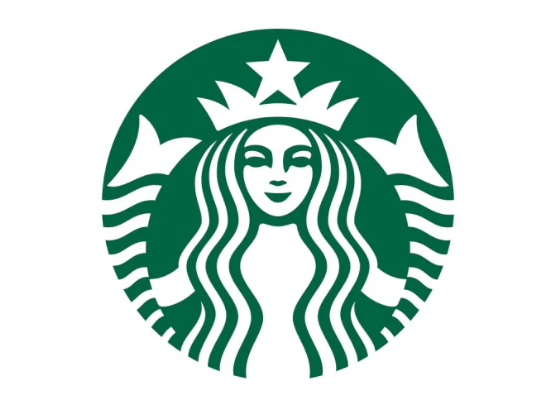The Starbucks Logo: History and What Makes it Work

We all know Starbucks and its unique logo. Now, do we know how the logo came into existence? Well Foundeck, in this article, we will describe the history of the Starbucks logo.
History
It all started in 1971, when 3 friends Jerry Baldwin, Zev Siegl and Gordon Bowker, who all met at the University of San Francisco, sat together and decided to provide people with roasted coffee beans which were very predominant at that time. They aimed to provide good coffee and a better coffee experience for people.
When they decided to open the first Starbucks store, they contacted a designer, Terry Heckler, to design a unique logo for their coffee shop. They wanted not only a unique logo but something that can be able to catch the attention of people, and also, an iconic logo that will be remembered for years.
The first and original logo was round, featuring a crown and a tailed siren in the middle, just like the present Starbucks logo. However, that is the only similarity between the first and the present Starbucks logo. The first logo contained a more detailed and bold siren design, showing a bare-breasted character which was inspired by traditional woodcut prints. The logo also had the words "Starbucks Coffee, Tea, Spices" all wrapped around the siren, which put more emphasis on the products they offered at that time.
The color was brown, which was chosen to give a feeling of calm and stability, as well as to reflect the natural and earthy nature of coffee and other items they were selling. It also featured a detailed black-and-white drawing of a bare-chested siren, framed by a circle. Surrounding the circular siren were the words "Starbucks Coffee and Tea". although the logo was simple, yet striking, setting the stage for the brand's identity.
A New Beginning for Starbucks
In 1982, a young New Yorker, Howard Schultz, who loves coffee, joined Starbucks in the position of director of operations and marketing. After a year of working at Starbucks, during a trip to Milan, Schultz was attracted to the Italian culture of coffee. What impressed him the most was how artistic and careful the coffee in Italy was made.
After this experience, when he returned to Seattle, he had a vision to bring the same coffee culture he had experienced in Italy, to the United States but the founders of Starbucks did not buy into Schultz's idea.
With his determination to make this happen, Schultz left Starbucks and opened his own coffee company "II Giornale". His new coffee company was more focused on creating Italian-style coffees. It wasn't until long that Schultz had a great opportunity to make his dream come through. In 1987, he purchased Starbucks for $3.8 million. After purchasing Starbucks, he merged his company II Giornale and Starbucks and retained the name Starbucks.
This was a new beginning for Starbucks and marked a significant expansion for the company. Schultz began opening other Starbucks stores outside of Seattle bringing his vision of producing a unique Italian cultured coffee to a wider and bigger audience.
The 1982 logo featured a more abstract version of the siren compared to the first design. In this version of the logo, the siren's long hair was placed to cover her chest, making the image look less sensitive and provocative. The drawing, however, retained its black and white color, but the green circular frame. This green circular frame added a touch of color and freshness to the logo. On the green border, the words "Starbucks Coffee" were written encircling the siren.
Again, Terry Heckler was once called to modernize the Starbucks siren, but this time, blending the elements from both the Starbucks and II Giornale. The new logo Heckler designed contained the starred crown and double tail of the siren, but this time, he gave her a significant makeover. Her hair in this logo was made to cover her breasts, which made the image less sensitive. The original textured strokes were replaced with bolder, more contemporary lines. He also updated the colors, adding black and the shade of green used by II Giornale, giving the logo a new and modern look. In the new design, the words "tea" and "spices" were dropped, which left the words "Starbucks Coffee".
The design, however, marked a new beginning for Starbucks. After two years of redesigning the logo, Starbucks expanded to 46 stores and was roasting more than two million pounds of coffee annually. The logo therefore, played a key role in the refining of the brand's identity during a period of rapid growth and also helped in solidifying its place in the coffee market.
In the early 1990s, Starbucks rapidly established itself as a major brand in the coffee market. By 1992, 140 Starbucks stores were operating across various cities. This move marked a significant milestone in Starbucks' history. At the time of its initial public offering, the company's market value had already reached about $271 million. This growth reflected not only the popularity of its coffee but also the strong brand identity that had been developed, supported in part by its distinctive logo and the unique coffee culture it promoted.
At the end of the 20th century, Starbucks decided to make changes to its logo but was very careful not to alter it. The redesign in 1992 was focused on simplifying the inside by zooming in on the siren's face, eliminating details that were not important and emphasizing her friendly and inviting grin.
However, the 1992 logo was very similar to that of the 1982 version, with notable differences. The siren had an enlarged face and the bottom half of her figure was not visible. The design helped to create a neater and more focused look. The siren, however, remains red surrounded by the circular green border, which continues to bear the words Starbucks coffee.
In 2011, as Starbucks celebrated its 40th anniversary, the company decided it was time for another update to its logo. They commissioned the renowned American marketing company Lippincott to collaborate with their in-house design team to create a fresh new look.
The Starbucks logo, which came out as a result of this collaboration, retained the siren present on the previous designs, which ensured continuity and brand recognition. But some notable changes were made. The color of the logo's background was changed from Bosch to green, which gave the logo a new look. While the logo was still left with a circular buffer, the words were removed, giving it a clearer look. The most notable change was the removal of the words from the circular border.
Connie Birdsall, Lippincott's global creative director, explained this to Fast Company in 2018: "As a team, we were like, 'There's something not working here, what is it?'" The issue stemmed from the siren's evolution. After her first modernization in 1987, her face had transformed from a textured, woodcut-style portrait to an almost eerily perfect, entirely symmetrical graphic. While this change aimed to modernize the logo, it inadvertently made the siren appear less human and more artificial.
The design team, however, recognized the imperfections and worked on refining the siren's face to introduce human touches, ensuring that the siren looks more relatable and welcoming while still maintaining her iconic status. Connie Birdsall, Lippincott's global creative director, reflected on this process, saying, "It was like, 'Oh, we need to step back and put some of that humanity back in.'"The goal was to create a contemporary look that still felt friendly and approachable.
In the new logo, the siren's face was made to feature a slight asymmetry to make her appear more human and less perfect. Looking closely, you'll see that the line running down to her nose on the right side dips a bit lower than the one on the left. Additionally, her features and proportions have been slightly adjusted—not enough to make her look like a different character, but just enough to enhance her mysterious allure. These changes were made to bring the sense and feel of humanity to the logo of Starbucks.
The Name
The meaning behind the brand name Starbucks has an interesting backstory. In 1971, the founders were searching for a name for their new coffee company. They believed words starting with a "St" had an appealing and memorable quality. Initially, the company considered the name "Starbo", which they found on a map as the name of an old mining town. But they kept searching for another name.
During the brainstorming, they came across the name "Starbuck", which at that time, was the name of a character in Herman Melville's maritime novel, "Moby Dick". The name, however, resonated with the founders not only because it has a St as the start but also because of the spirit it evoked. They concluded that since the company was focused on selling coffee and tea, the name fit very well with the brand.
As explained by the Starbucks website, the name was chosen because it represented the seafaring tradition of the early coffee traders. The siren of the logo tried to explain its nautical theme, symbolizing allure and the global journey of its products. After combining these elements, Starbucks created a name and logo that were both unique and portrayed historical significance, setting the stage for the brand's stories.
For the formation of the logo, during Heckler's research, Heckler discovered a Norse woodcut from the 16th century depicting a two-tailed siren. This image captured his imagination and became the foundation for the Starbucks logo. In an interview with the Seattle Times in 2011, Heckler explained that the siren served as a metaphor for the allure of caffeine, similar to the mythical sirens who lured sailors to the rocks with their enchanting voices. The logo's inviting and captivating aura perfectly complemented the brand's mission of making great coffee from around the world accessible in an appealing and welcoming environment.
Adding the siren to the logo helped Heckler to create a visual connection to the seafaring tradition, which reinforced the idea of Starbucks being a place where people can get a good experience of rich and diverse flavors of coffee from all comers of the world. The siren, combined with the theme of the logo, is central to the ideas of the Starbucks brand, explaining the quality of the coffee and the inviting space they aim to provide for their customers.
The Starbucks logo is highly effective due to its easy approachability and distinctiveness. One major factor in the logo's success was the decision made in 1987 to change the logo's color from black to a more vibrant and positive shade of green. Howard Schultz, in his memoir "Pour Your Heart Into It: How Starbucks Built a Company One Cup at a Time," explains that this decision made the logo stand out and unique and feel more inviting. By going for this invigorating green, Starbucks ensured that its logo would be easily recognizable and visible, which was important for a brand with a worldwide presence.
Starbucks itself appreciates the importance of this color on their website, stating, "Our green is iconic. Visible for blocks. It's our most identifiable asset, from the color of our aprons to our logo."This particular shade of green has become synonymous with the Starbucks brand, making it instantly recognizable.
After the 2011 change of logo, the company notes on its website, "What's notably absent from our current logo? Our name. Starbucks' global reach extends beyond the bounds of coffee, and our Siren, now so familiar, can surely stand on her own."
When Starbucks changed its logo from a soft brown to a bold green, it managed to keep the natural elements while making the design more noticeable in urban areas. This change made sure that the logo remained true to its roots, reflecting nature and organic products, but also became more unique and easier to spot in crowded city environments.
Conclusion
When creating a company's logo, one very important aspect is to think about how color will affect what people will see your brand as. The colors you choose for your brand give people different information and certain perspectives of your brand. For example, Starbucks used green to represent growth, freshness, and the environment, which goes well with what the brand does.



